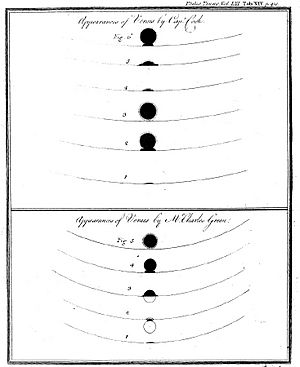Charles Green (astronomer) facts for kids
Charles Green (born in December 1734 – died 29 January 1771) was a British astronomer. He is famous for being chosen by the Royal Society in 1768 to join an important trip to the Pacific Ocean. His job was to observe the transit of Venus from James Cook's ship, the Endeavour.
Contents
Early Life and Learning
Charles Green was born in December 1734. He was the youngest son of Joshua Green, a successful farmer from Swinton in Yorkshire. Charles went to a school in Soho, London, run by his older brother, John Green. Charles later became an assistant teacher there. He kept studying astronomy until he joined the Royal Greenwich Observatory in 1760.
Working as an Astronomer
Green became an assistant to the top astronomer, James Bradley, in 1760. He took over from Charles Mason, who left to observe the 1761 transit of Venus in South Africa. After Bradley passed away in 1762, Green continued as assistant to the next Astronomer Royal, Nathaniel Bliss. Because Bliss was often unwell, Green did most of the actual astronomy work.
In 1763, Green and another astronomer, Nevil Maskelyne, went on a trip to Barbados. Their mission was to test a special clock called the H4 chronometer, made by John Harrison. This clock was competing for the Longitude Prize, a big reward from the British government for finding a way to accurately tell a ship's longitude at sea. Green and Maskelyne compared the clock's time with their own observations of the sky to see how accurate it was.
Green returned to England in late 1764, just as Nathaniel Bliss died. Green went back to Greenwich to continue the work until a new Astronomer Royal was chosen. This new person turned out to be Nevil Maskelyne. Green worked for him briefly but left after they had a disagreement.
Despite their earlier disagreement, Maskelyne later suggested Green to the Royal Society for a very important job. In 1768, Green was chosen to go with James Cook on his voyage to observe the 1769 transit of Venus.
Voyage of the Endeavour and the Transit of Venus
Green joined Cook's first voyage around the world in 1768. He was one of two official astronomers sent by the Royal Society to observe the transit. Captain Cook himself was also a skilled observer. Green was paid 200 guineas by the Society for this important task. The Society also provided special equipment, including telescopes and clocks.
The expedition arrived at Tahiti, the chosen spot for observing the transit, on April 11, 1769. They set up a camp called Fort Venus. Green's first job was to figure out the exact location of the camp using stars and planets.
The day of the transit, June 3, was clear, and the transit was fully visible. Green, Cook, and another scientist named Daniel Solander all recorded the times of the transit. However, their recorded times were a bit different. This difference is now known as the black drop effect. This made the Royal Society question how useful the observations were later on.
Looking at Green's Observations
Because Green died on the way home, Captain Cook and later Nevil Maskelyne had to organize and analyze his notes. Cook said that Green's papers were messy, and some timings were written down differently in various places. Maskelyne was critical of Green's work, especially how he calculated the location of Fort Venus.
However, it has been noted that even though the times recorded by Green, Cook, and Solander were different, no one observer was consistently wrong. A writer named Wharton, in an 1893 book about Captain Cook, praised Green's work. He said that Green was likely responsible for most of the accurate longitude measurements on the voyage, which was a remarkable achievement.
Journey of the Endeavour and Green's Death
After leaving Tahiti, the Endeavour continued exploring the Southern Ocean. In October 1769, the expedition reached New Zealand. This gave Green another chance to observe a rare event: the transit of Mercury. They landed at a place later named Mercury Bay, and Green successfully observed the transit on November 9.
While Cook sailed along the coast of Australia, he named an island Green Island after the astronomer in June 1770. By this time, Green had become sick with scurvy.
The Endeavour had to stop in Batavia (now Jakarta) for repairs. Many diseases were common in the city, including malaria and dysentery. Green caught dysentery and died on January 29, 1771, shortly after the ship left the port. Captain Cook wrote in his log that Green had been unwell for some time and his health had gotten worse.
Personal Life
Charles Green married Elizabeth Long in March 1768 in London. The Royal Society made sure his wife would receive £50 each year while he was away on the expedition. Green's sister, Mary, married another astronomer named William Wales. William Wales was part of a different Royal Society trip to observe the 1769 transit of Venus from Hudson Bay. He later replaced Green on Cook's next voyage.
See also
- 1769 Transit of Venus observed from Tahiti
- First voyage of James Cook
- European and American voyages of scientific exploration


